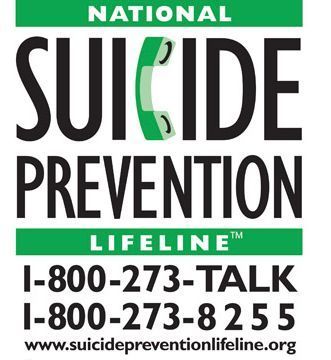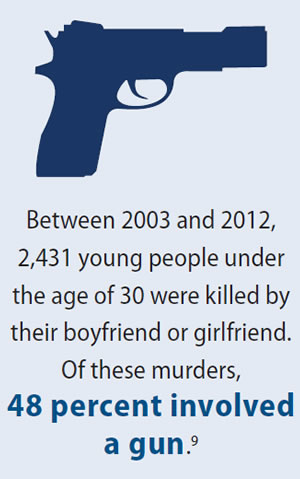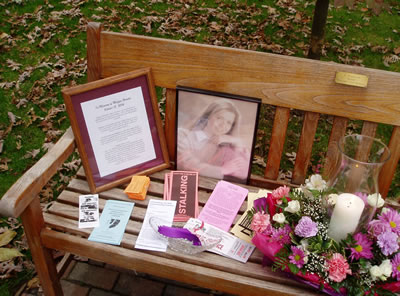 Maggie was born August 23, 1980, in Kalamazoo, Michigan, and lived in this area all her life. She attended Haverhill Elementary School in Portage, and Cooper Elementary School in Plainwell. Maggie attended Plainwell Middle School and graduated from Plainwell High School in 1998. At the time of her death, she was a sophomore at Kalamazoo College.
Maggie was born August 23, 1980, in Kalamazoo, Michigan, and lived in this area all her life. She attended Haverhill Elementary School in Portage, and Cooper Elementary School in Plainwell. Maggie attended Plainwell Middle School and graduated from Plainwell High School in 1998. At the time of her death, she was a sophomore at Kalamazoo College.
Accomplished on the French horn, she played in the high school marching and symphonic band, and in the Kalamazoo College Symphonic band. She played basketball in high school and loved to play golf in the summer. She was a proud member of the Kalamazoo College women’s golf team. She was hard working and determined at everything she tried.
The summer of 1999 she was proud of her work in construction with her Uncle Pete. Her interests were varied, including stamp and insect collections, classical music, playing the piano, a love of the outdoors and outdoor photography.
She was a loving daughter and her family remembers her as a good friend and confidant to many people, and was proud to see her blossom into a mature person with a loving heart. Maggie was a member of St. Augustine Cathedral and had completed confirmation in the spring of 1999.
Her family includes her parents and their spouses, Rick and Martha, and Bob and Sandi; her brother, Rob; her grandmothers, Luzia, Corinne, and Josephine; numerous aunts and uncles, many cousins and a special friend, Sarah.
Maggie died on October 18, 1999, in Kalamazoo and was buried from the Rupert, Durham, Marshall and Gren Funeral Home in Plainwell.
Her funeral Mass was celebrated at St. Augustine Cathedral in Kalamazoo, Michigan on Friday, October 22, 1999, and she was buried in a family plot at West Cooper Cemetery.
A Family’s Plea
 Since the early morning hours of October 18, 1999, Maggie’s family has struggled to understand what happened to her and why it happened.
Since the early morning hours of October 18, 1999, Maggie’s family has struggled to understand what happened to her and why it happened.
We have talked to the police department, her friends and teachers at Kalamazoo College, and read the reports of the events leading to that horrendous, fateful moment when another person took her life. We still struggle with the basic questions of “Why did this happen to her/us?” and “Why did this terrible thing happen to a good person like her?”
We were all naïve to believe that because we loved her and protected her so much that she was safe from violence. Because this has happened to our Maggie, we know that it can happen to any of us, in any family, in any town, from any background, at any time. It does not mean that we have to live in fear of violence but that we must do something to decrease violence where we live.
Before Maggie died, we felt, like most people do, that this would never happen to us or our family. But now we are connected to others who have lost loved ones to violence and we know we must try and do something about it.
Our plea is that you explore three particular facets of violence in light of Maggie’s death and see what you can do as individuals and families to change the prevalence of this violence in our society. We can’t save Maggie now, but violence can be prevented!
SUICIDE PREVENTION
 The person who murdered Maggie did not apparently threaten or abuse her outwardly as evidenced by others. But he did talk about and act out some intentions to hurt himself before he committed the murder/suicide. It seems that everyone who knew him, including members of Maggie’s family, missed those signs or thought they were not as serious threats to himself as they actually were. His state of mind is more apparent in retrospect and no one could have prevented what happened to Maggie at the time.
The person who murdered Maggie did not apparently threaten or abuse her outwardly as evidenced by others. But he did talk about and act out some intentions to hurt himself before he committed the murder/suicide. It seems that everyone who knew him, including members of Maggie’s family, missed those signs or thought they were not as serious threats to himself as they actually were. His state of mind is more apparent in retrospect and no one could have prevented what happened to Maggie at the time.
But we can try to pay better attention to others in crisis in the future and try to stop them from hurting themselves or others out of personal despair and unhappiness. It is particularly important for adolescents and young adults to reconsider misgivings about violating personal privacy or “telling on others” when someone they know is in crisis and in danger of hurting themselves. Learn the signs of problems and know where to get help – we can’t always help them out by being their friend and talking them out of it. Get help for them at school or at an agency with trained, professional staff.
SUICIDE PREVENTION LINKS
GUN CONTROL
 The person who murdered Maggie was able to obtain a powerful hunting rifle with a scope from a local gun shop and conceal it from others on his dorm floor. He was able to purchase it “legally” and use his address at his college. He also purchased it, apparently as a first-time firearm owner, with only a 24-hour waiting period and no check of his background with his hometown police agency in Seattle. Without checking all the local, state and national laws governing guns, it appears to be common sense that a gun purchase should not be allowed with a temporary residence address such as an obvious college dormitory listing.
The person who murdered Maggie was able to obtain a powerful hunting rifle with a scope from a local gun shop and conceal it from others on his dorm floor. He was able to purchase it “legally” and use his address at his college. He also purchased it, apparently as a first-time firearm owner, with only a 24-hour waiting period and no check of his background with his hometown police agency in Seattle. Without checking all the local, state and national laws governing guns, it appears to be common sense that a gun purchase should not be allowed with a temporary residence address such as an obvious college dormitory listing.
Declaring a true, permanent residence at time of purchase would allow a more complete background check and would also possibly make those who know the purchaser aware of the impending purchase. In addition, there ought to be a law that a gun shop owner notify college authorities if a gun has been purchased using a college address. There is no reason, at any time, for anyone to keep a gun on school grounds or on a college campus without severe disciplinary and legal action. Many colleges have a no-tolerance policy about guns on campus, yet according to a recent (mid-2000s) study by the Harvard School of Public Health, 3.5 percent of college students — or about 450,000 nationwide– keep a working firearm at school!
Anyone with knowledge of a gun on campus must report that information to campus authorities. It would seem to be necessary for all students and their parents to insist on this level of safety.
GUN CONTROL LINKS
VIOLENCE AGAINST WOMEN
 The person who murdered Maggie would not accept that she had broken off her relationship with him. He used her sense of compassion and desire to not hurt others in order to string out his contact with her longer than she really wanted. In this way, he stalked her through e-mail, ICQ chats and instant messaging on the computer, over the phone to her and her friends, and by the proximity of their dorm rooms and campus activities. He used her willingness to help him work out their breakup and to help him with his college course work. He really wanted to possess her and could not accept that she would be happy with anyone else.
The person who murdered Maggie would not accept that she had broken off her relationship with him. He used her sense of compassion and desire to not hurt others in order to string out his contact with her longer than she really wanted. In this way, he stalked her through e-mail, ICQ chats and instant messaging on the computer, over the phone to her and her friends, and by the proximity of their dorm rooms and campus activities. He used her willingness to help him work out their breakup and to help him with his college course work. He really wanted to possess her and could not accept that she would be happy with anyone else.
When it became apparent to him that he could not prevent her from moving on without him and that his continued success at school was in jeopardy, he stalked her and then resorted to violence in a final selfish act of murder-suicide.
Our gentle, kind Maggie was the victim of violence against a woman, as a means to control and possess her. This is a horrible act that should not occur in our society, and it is immensely unbelievable that it happened to her who was raised to be non-violent and to show compassion and caring for others. We must learn to help and stop those among us who would hurt women and children as a means to control them.
VIOLENCE AGAINST WOMEN LINKS
UPDATE: August 4, 2015
After a few years of reflection on what happened to Maggie, it became apparent to us that a lack of knowledge of the nature of healthy relationships was a major factor in what happened to her. Most significantly, his lack of understanding of what love is, and how to show trust and respect in a healthy relationship is apparent in retrospection. Maggie, her family and friends all missed the signs of danger that were there to see. Verbal and emotional abuse can be significant and harmful, and victims of abuse report its effects can be worse than physical abuse. And sadly, it can be accepted by the victim, as a sign of the abuser’s love in teen dating relationships. Or it can be accepted as part of the ups and downs of a relationship that teens think “everyone” experiences. Or, as in Maggie’s case, it can be accepted as a sign of the immaturity of the partner that might be changed in the future.
In reality these abusive behaviors are signs of unhealthy and abusive relationships. Our work, in Maggie’s memory, now focuses on helping young people learn about the components of healthy relationships and the warning signs of dating abuse.
HEALTHY RELATIONSHIPS AND WARNING SIGN LINKS
- Relationship Spectrum – Healthy / Unhealthy / Abusive Patterns in dating relationships
- Take the Relationship Spectrum Quiz
- Warning Signs of Teen Dating Abuse
- What is a Healthy Relationship?
- Have a Healthy Online Relationship
Please remember Maggie everyday by working on these critical issues which led to her untimely, senseless death. . . she would have done the same for any of us.
KALAMAZOO COLLEGE STUDENTS KILLED: APPARENT MURDER-SUICIDE
 KALAMAZOO, Mich. (AP) — Gun violence has found its way to a close-knit private college here when a man killed his ex-girlfriend and then turned the shotgun on himself.
KALAMAZOO, Mich. (AP) — Gun violence has found its way to a close-knit private college here when a man killed his ex-girlfriend and then turned the shotgun on himself.
Neenef Odah, 20, of Seattle, apparently shot Margaret “Maggie,” 19, of Plainwell twice before killing himself in his Kalamazoo College dormitory room, said Capt. Jerome Bryant of the Kalamazoo Department of Public Safety.
Campus security discovered the students’ bodies about 12:15 a.m. Monday in Odah’s first-floor room in DeWaters Residence Hall, a three-story brick building that houses about 110 students.
The two had been dating on and off for a year, but were not dating at the time of the shooting, police said. Several students told police Odah had grown jealous following a dance where he apparently saw Maggie with another man, said Lt. Larry Belen of the Kalamazoo Department of Public Safety.
Sarah, Maggie’s best friend, said Odah wanted to have a serious relationship with Maggie but she was not ready to commit. They broke up this year. Sarah called Maggie “an extraordinary person… She was such a bright girl, she was so smart and she was kind to everybody.”
Police received a call of shots fired from a student at DeWaters Hall. They found Maggie and Odah dead.
Maggie, a member of the golf team at K-College, was described as a bright, athletic girl with a promising future. She graduated in 1998 from Plainwell High School where she played on the girl’s basketball team. She was a talented French horn player and a member of the National Honor Society.
“She was an outgoing person,” said friend Kristie, a student at Howard University in Washington D.C. “She’s an individual. She liked to do things her way and she didn’t care about what others thought too much.”
News of the deaths spread quickly on campus. Stunned students wept or walked arm in arm this morning. Classes and school events were canceled and counselors were dispatched to residence halls to assist in the grieving process. A campuswide e-mail notice was sent to all students, informing them of the deaths.
“From what I’m seeing, it’s obvious that everyone’s in shock,” one faculty member said. “It doesn’t make any sense to anybody.”
